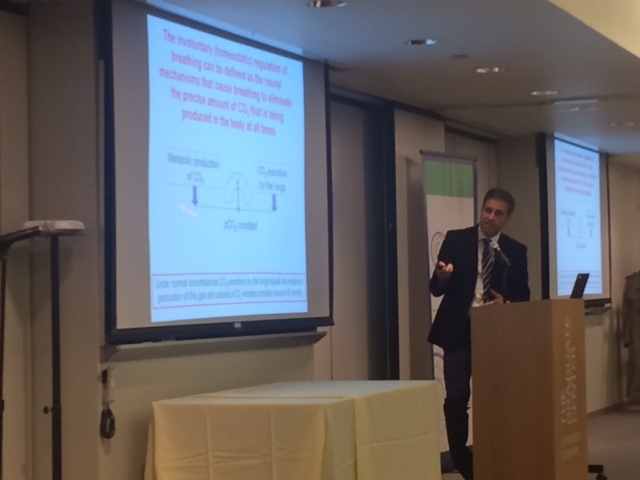

A deeper understanding of the brainstem circuits can explain the role of astrocytes and the vascular system as underlying mechanisms of breathing (Thiago dos Santos Moreira, Professor at the Biomedical Sciences Institute of the University of São Paulo (ICB-USP), during his talk at FAPESP Week New York/ photo: Maria Fernanda Ziegler, Agência FAPESP).
A deeper understanding of the brainstem circuits can explain the role of astrocytes and the vascular system as underlying mechanisms of breathing.
A deeper understanding of the brainstem circuits can explain the role of astrocytes and the vascular system as underlying mechanisms of breathing.

A deeper understanding of the brainstem circuits can explain the role of astrocytes and the vascular system as underlying mechanisms of breathing (Thiago dos Santos Moreira, Professor at the Biomedical Sciences Institute of the University of São Paulo (ICB-USP), during his talk at FAPESP Week New York/ photo: Maria Fernanda Ziegler, Agência FAPESP).
By Maria Fernanda Ziegler, in New York | Agência FAPESP – Breathing is essential to life. Its best-known function is to bring oxygen into the body and remove carbon dioxide (CO2) from it. However, the underlying mechanisms that govern the act of breathing in and out are still not fully understood.
Three new findings have recently been added to the respiratory puzzle: the essential work of neurons in breathing, the role of astrocytes (glial cells that sustain and nourish the neurons) and the function of the vascular system.
“We have seen that there are three units working together so that there is adequate pulmonary ventilation. One is the neuron, which by itself is critically important in controlling breathing activity. The second unit is the astrocyte, releasing neurotransmitters, among them, ATP (adenosine triphosphate), to modulate the activity of that neuron. More recently, we have also discovered the function of the vascular system, with its activity of constricting or dilating in order to increase or decrease the concentration of CO2 in the area,” said Thiago dos Santos Moreira, a professor at the Biomedical Sciences Institute of the University of São Paulo (ICB-USP), during his talk at FAPESP Week New York.
The meeting, held at the City University of New York (CUNY) November 26-28, 2018, involved Brazilian and U.S. researchers with the aim of strengthening research partnerships.
Moreira leads the FAPESP-funded thematic project, "Retrotrapezoid nucleus, central chemoreception and breathing automaticity" whose research studies have helped explain the mechanisms that govern breathing in mammals.
In breathing, the body’s cells use oxygen to decompose food and release energy. In doing so, however, they produce CO2 as a waste product that is released into the bloodstream. As a result, it needs to be carried to the lungs and expelled.
It was already known that neurons from the area of the brainstem called the retrotrapezoid nucleus (RTN) controlled breathing through an intrinsic ability to detect the increase in the concentration of CO2 and influence the breathing centers in the brain.
“We also had some prior basic knowledge that astrocytes could modulate breathing. We conducted a series of studies showing that the astrocytes release neurotransmitters and that the neurotransmitter is the ATP,” he said.
Moreira explained that ATP (the substrate of the enzyme) acts on a specific receptor in the neuron to control breathing. The astrocytes also contribute to chemoreception in the RTN.
This was because there was a paradox in not including the action of the vascular system among the mechanisms of breathing. If high levels of CO2 cause the blood vessels in the areas of the brain that contain respiratory chemoreceptors to dilate, it would, in theory, eliminate that important stimulus, reducing breathing activity.
By studying the brains of adult rats, Moreira’s group discovered that different rules apply to the brain centers responsible for controlling breathing than those that apply to other areas of the brain.
If the blood becomes too acidic in the areas that control breathing, the astrocytes release chemical signals, such as the neurotransmitters called purines. This promotes a reduction in the size of the blood vessels in the area of the brainstem responsible for detecting CO2 levels and thus enables increased activation of the astrocytes and neurons to increase breathing and restore respiratory physiology.
“The vascular system therefore reduces or increases the size of the blood vessels by means of variations in CO2, regulating how much CO2 should act in the neuron and how much should be washed out of the blood,” he said.
The mechanism ensures that the local levels of CO2 in the respiratory centers of the brain remain in sync with the demands of local networks, thus maintaining breathing activity.
According to Moreira, his next challenge will be to identify the molecular mechanisms that control dilation and constriction of the blood vessels in areas of the brain that contain respiratory chemoreceptors, and determine whether medicines that modulate those mechanisms have the potential to treat some of the respiratory dysfunctions found in certain types of diseases such as obstructive sleep apnea, Parkinson’s disease and epilepsy.
Republish
The Agency FAPESP licenses news via Creative Commons (CC-BY-NC-ND) so that they can be republished free of charge and in a simple way by other digital or printed vehicles. Agência FAPESP must be credited as the source of the content being republished and the name of the reporter (if any) must be attributed. Using the HMTL button below allows compliance with these rules, detailed in Digital Republishing Policy FAPESP.





